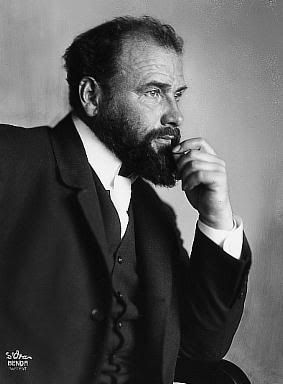HOPPING THROUGH KLIMT
As indicated on the main page, this is all the work of a layman. I am not an art scholar; merely someone with an abiding interest who is attempting to learn as much as possible while sharing some of what I've learned. Also, since I'm basically commenting on works as the inspiration strikes me, these will not be presented in chronological order (hence, the hopping of the title).
Gustav Klimt (1862-1918), b. Baumgarten, Austria

The artist, circa 1908.
Gustav Klimt is not an easy artist to classify. He is generally referred to as a member of the Art Nouveau, or Jugendstil as it was called in his neck of the woods, a movement characterized by paintings utilizing ornamental, decorative touches often inspired by nature, which is a fitting description of some of his work. But he was also known to incorporate elements of Impressionism from time to time, and he, like many Prussian artists of the era and the several decades that followed, is linked to Expressionism (a term itself difficult to define), both through select pieces from his own catalog and his friendship with and influence on the Expressionist Egon Schiele (who I hope to examine at some later point). And it would be unthinkable to examine Klimt’s work without considering the assorted antiquities that inspired him so.
This latter point was a big part of what led Klimt to co-form the Vienna Secession, a group of younger artists who broke away from their predecessors in a battle between Historicists and Modernists. This was an ideological difference between embracing the past and letting it lie, although which side was which may not be as easy to guess as one might think. The Historicists considered art to be an ever-evolving form that need never look back – in their view, once a particular period was over, it was over – whereas the Modernists wanted to be free to incorporate anything that had come before that stirred them. Indeed, to look at certain Klimt pieces, it is clear that he did not just wish to incorporate images from the past – he wanted to make them vibrant enough to seem to be things of the present. This included not shying away from their inherent eroticism when appropriate, a tendency that would cause him some trouble (though not as much as certain thematic approaches).
But while sex was an abiding element of much art from this period and the decades to follow, sometimes in forms more explicit than might be expected of the time, Klimt’s works have a vibrancy to them that makes the eroticism radiate out from the canvas. Klimt clearly loved painting women, and the lion’s share of his allegorical images would be expressed through their assorted forms and shapes, although to view them as merely symbolic is to miss out on part of the picture. Indeed, he seems, when painting mythological figures, to be attempting to transcend their stature as mythological figures, to humanize them, and sensualize them, in a way that will speak more to the viewer’s sense of themselves than their sense of history.
The Works:
The Kiss (1907-08)
Danae (1907-08)
The Faculty Paintings (1907)
Assorted water maidens (1889 through 1907)
Judith I (1901) & Judith II (1909)


0 Comments:
Post a Comment
Subscribe to Post Comments [Atom]
<< Home